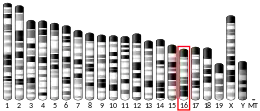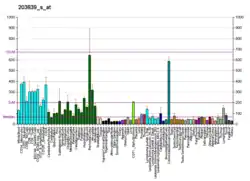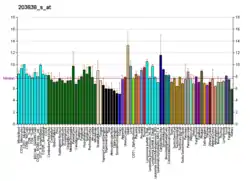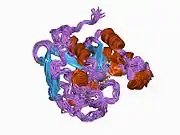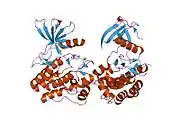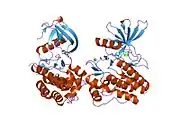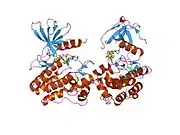Activated CDC42 kinase 1, also known as ACK1, is an enzyme that in humans is encoded by the TNK2 gene. [5][6][7][8][9] TNK2 gene encodes a non-receptor tyrosine kinase, ACK1, that binds to multiple receptor tyrosine kinases e.g. EGFR, MERTK, AXL, HER2 and insulin receptor (IR). ACK1 also interacts with Cdc42Hs in its GTP-bound form and inhibits both the intrinsic and GTPase-activating protein (GAP)-stimulated GTPase activity of Cdc42Hs. This binding is mediated by a unique sequence of 47 amino acids C-terminal to an SH3 domain. The protein may be involved in a regulatory mechanism that sustains the GTP-bound active form of Cdc42Hs and which is directly linked to a tyrosine phosphorylation signal transduction pathway. Several alternatively spliced transcript variants have been identified from this gene, but the full-length nature of only two transcript variants has been determined.[9]
Interactions
ACK1 or TNK2 has been shown to interact with AKT,[7] Androgen receptor or AR,[10] a tumor suppressor WWOX,[11] FYN[12] and Grb2.[13][14] ACK1 interaction with its substrates resulted in their phosphorylation at specific tyrosine residues. ACK1 has been shown to directly phosphorylate AKT at tyrosine 176, AR at Tyrosine 267 and 363, and WWOX at tyrosine 287 residues, respectively. ACK1-AR signaling has also been reported to regulate ATM levels,[15]
Clinical relevance
ACK1 is a survival kinase and shown to be associated with tumor cell survival, proliferation, hormone-resistance and radiation resistance.[5] The activation of ACK1 has been observed in prostate, breast, pancreatic, lung and ovarian cancer cells.[5][7][10][16] ACK1 transgenic mice, expressing activated ACK1 specifically in prostate gland has been reported; these mice develop prostatic intraepithelial neoplasia (PINs).[7]
ACK1 inhibitors
Ack1 has emerged as a new cancer target and multiple small molecule inhibitors have been reported.[17] [18][19] All of these inhibitors are currently in the pre-clinical stage.
Mahajan, K., Malla, P., Lawrence, H. R., Chen, Z., Kumar-Sinha, C., Malik, R., … Mahajan, N. P. (2017). ACK1/TNK2 Regulates Histone H4 Tyr88-phosphorylation and AR Gene Expression in Castration-Resistant Prostate Cancer. Cancer Cell, 31(6), 790-803.e8. https://doi.org/10.1016/j.ccell.2017.05.003
- 1 2 3 GRCh38: Ensembl release 89: ENSG00000061938 - Ensembl, May 2017
- 1 2 3 GRCm38: Ensembl release 89: ENSMUSG00000022791 - Ensembl, May 2017
- ↑ "Human PubMed Reference:". National Center for Biotechnology Information, U.S. National Library of Medicine.
- ↑ "Mouse PubMed Reference:". National Center for Biotechnology Information, U.S. National Library of Medicine.
- 1 2 3 Mahajan K, Mahajan NP (August 2010). "Shepherding AKT and androgen receptor by Ack1 tyrosine kinase". J. Cell. Physiol. 224 (2): 327–23. doi:10.1002/jcp.22162. PMC 3953130. PMID 20432460.
- ↑ Manser E, Leung T, Salihuddin H, Tan L, Lim L (June 1993). "A non-receptor tyrosine kinase that inhibits the GTPase activity of p21cdc42". Nature. 363 (6427): 364–7. Bibcode:1993Natur.363..364M. doi:10.1038/363364a0. PMID 8497321. S2CID 4307094.
- 1 2 3 4 Mahajan K, Coppola D, Challa S, Fang B, Chen YA, Zhu W, Lopez AS, Koomen J, Engelman RW, Rivera C, Muraoka-Cook RS, Cheng JQ, Schönbrunn E, Sebti SM, Earp HS, Mahajan NP (March 2010). "Ack1 mediated AKT/PKB tyrosine 176 phosphorylation regulates its activation". PLOS ONE. 5 (3): e9646. Bibcode:2010PLoSO...5.9646M. doi:10.1371/journal.pone.0009646. PMC 2841635. PMID 20333297.
- ↑ Yokoyama N, Miller WT (November 2003). "Biochemical properties of the Cdc42-associated tyrosine kinase ACK1. Substrate specificity, authphosphorylation, and interaction with Hck". J Biol Chem. 278 (48): 47713–23. doi:10.1074/jbc.M306716200. PMID 14506255.
- 1 2 "Entrez Gene: TNK2 tyrosine kinase, non-receptor, 2".
- 1 2 Mahajan NP, Liu Y, Majumder S, Warren MR, Parker CE, Mohler JL, Earp HS, Whang YE (May 2007). "Activated Cdc42-associated kinase Ack1 promotes prostate cancer progression via androgen receptor tyrosine phosphorylation". Proc Natl Acad Sci U S A. 104 (20): 8438–43. Bibcode:2007PNAS..104.8438M. doi:10.1073/pnas.0700420104. PMC 1895968. PMID 17494760.
- ↑ Mahajan NP, Whang YE, Mohler JL, Earp HS (November 2005). "Activated tyrosine kinase Ack1 promotes prostate tumorigenesis: role of Ack1 in polyubiquitination of tumor suppressor Wwox". Cancer Res. 65 (22): 10514–23. doi:10.1158/0008-5472.can-05-1127. PMID 16288044.
- ↑ Linseman DA, Heidenreich KA, Fisher SK (February 2001). "Stimulation of M3 muscarinic receptors induces phosphorylation of the Cdc42 effector activated Cdc42Hs-associated kinase-1 via a Fyn tyrosine kinase signaling pathway". J. Biol. Chem. 276 (8): 5622–8. doi:10.1074/jbc.M006812200. PMID 11087735.
- ↑ Satoh T, Kato J, Nishida K, Kaziro Y (May 1996). "Tyrosine phosphorylation of ACK in response to temperature shift-down, hyperosmotic shock, and epidermal growth factor stimulation". FEBS Lett. 386 (2–3): 230–4. doi:10.1016/0014-5793(96)00449-8. PMID 8647288. S2CID 23523548.
- ↑ Kato-Stankiewicz J, Ueda S, Kataoka T, Kaziro Y, Satoh T (June 2001). "Epidermal growth factor stimulation of the ACK1/Dbl pathway in a Cdc42 and Grb2-dependent manner". Biochem. Biophys. Res. Commun. 284 (2): 470–7. doi:10.1006/bbrc.2001.5004. PMID 11394904.
- ↑ Mahajan K, Coppola D, Rawal B, Chen YA, Lawrence HR, Engelman RW, Lawrence NJ, Mahajan NP (June 2012). "Ack1-mediated androgen receptor phosphorylation modulates radiation resistance in castration-resistant prostate cancer". J Biol Chem. 287 (26): 22112–22. doi:10.1074/jbc.M112.357384. PMC 3381169. PMID 22566699.
- ↑ Mahajan K, Coppola D, Chen YA, Zhu W, Lawrence HR, Lawrence NJ, Mahajan NP (April 2012). "Ack1 tyrosine kinase activation correlates with pancreatic cancer progression". Am J Pathol. 180 (4): 1386–93. doi:10.1016/j.ajpath.2011.12.028. PMC 3349895. PMID 22322295.
- ↑ Lawrence HR, Mahajan K, Luo Y, Zhang D, Tindall N, Huseyin M, Gevariya H, Kazi S, Ozcan S, Mahajan NP, Lawrence NJ (March 2015). "Development of novel ACK1/TNK2 inhibitors using a fragment-based approach". J Med Chem. 58 (6): 2746–63. doi:10.1021/jm501929n. PMC 4605435. PMID 25699576.
- ↑ Mahajan K, Mahajan NP (September 2012). "PI3K-independent AKT activation in cancers: a treasure trove for novel therapeutics". J. Cell. Physiol. 227 (9): 3178–84. doi:10.1002/jcp.24065. PMC 3358464. PMID 22307544.
- ↑ Mahajan K, Mahajan NP (April 2013). "ACK1 tyrosine kinase: Targeted inhibition to block cancer cell proliferation". Cancer Lett. 338 (2): 185–92. doi:10.1016/j.canlet.2013.04.004. PMC 3750075. PMID 23597703.
Further reading
- Maruyama K, Sugano S (1994). "Oligo-capping: a simple method to replace the cap structure of eukaryotic mRNAs with oligoribonucleotides". Gene. 138 (1–2): 171–4. doi:10.1016/0378-1119(94)90802-8. PMID 8125298.
- Satoh T, Kato J, Nishida K, Kaziro Y (1996). "Tyrosine phosphorylation of ACK in response to temperature shift-down, hyperosmotic shock, and epidermal growth factor stimulation". FEBS Lett. 386 (2–3): 230–4. doi:10.1016/0014-5793(96)00449-8. PMID 8647288. S2CID 23523548.
- Suzuki Y, Yoshitomo-Nakagawa K, Maruyama K, et al. (1997). "Construction and characterization of a full length-enriched and a 5'-end-enriched cDNA library". Gene. 200 (1–2): 149–56. doi:10.1016/S0378-1119(97)00411-3. PMID 9373149.
- Mott HR, Owen D, Nietlispach D, et al. (1999). "Structure of the small G protein Cdc42 bound to the GTPase-binding domain of ACK". Nature. 399 (6734): 384–8. Bibcode:1999Natur.399..384M. doi:10.1038/20732. PMID 10360579. S2CID 4313328.
- Eisenmann KM, McCarthy JB, Simpson MA, et al. (2000). "Melanoma chondroitin sulphate proteoglycan regulates cell spreading through Cdc42, Ack-1 and p130cas". Nat. Cell Biol. 1 (8): 507–13. doi:10.1038/70302. PMID 10587647. S2CID 16876663.
- Kato J, Kaziro Y, Satoh T (2000). "Activation of the guanine nucleotide exchange factor Dbl following ACK1-dependent tyrosine phosphorylation". Biochem. Biophys. Res. Commun. 268 (1): 141–7. doi:10.1006/bbrc.2000.2106. PMID 10652228.
- Owen D, Mott HR, Laue ED, Lowe PN (2000). "Residues in Cdc42 that specify binding to individual CRIB effector proteins". Biochemistry. 39 (6): 1243–50. doi:10.1021/bi991567z. PMID 10684602.
- Kiyono M, Kato J, Kataoka T, et al. (2000). "Stimulation of Ras guanine nucleotide exchange activity of Ras-GRF1/CDC25(Mm) upon tyrosine phosphorylation by the Cdc42-regulated kinase ACK1". J. Biol. Chem. 275 (38): 29788–93. doi:10.1074/jbc.M001378200. PMID 10882715.
- Linseman DA, Heidenreich KA, Fisher SK (2001). "Stimulation of M3 muscarinic receptors induces phosphorylation of the Cdc42 effector activated Cdc42Hs-associated kinase-1 via a Fyn tyrosine kinase signaling pathway". J. Biol. Chem. 276 (8): 5622–8. doi:10.1074/jbc.M006812200. PMID 11087735.
- Teo M, Tan L, Lim L, Manser E (2001). "The tyrosine kinase ACK1 associates with clathrin-coated vesicles through a binding motif shared by arrestin and other adaptors". J. Biol. Chem. 276 (21): 18392–8. doi:10.1074/jbc.M008795200. PMID 11278436.
- Kato-Stankiewicz J, Ueda S, Kataoka T, et al. (2001). "Epidermal growth factor stimulation of the ACK1/Dbl pathway in a Cdc42 and Grb2-dependent manner". Biochem. Biophys. Res. Commun. 284 (2): 470–7. doi:10.1006/bbrc.2001.5004. PMID 11394904.
- Oda T, Muramatsu MA, Isogai T, et al. (2001). "HSH2: a novel SH2 domain-containing adapter protein involved in tyrosine kinase signaling in hematopoietic cells". Biochem. Biophys. Res. Commun. 288 (5): 1078–86. doi:10.1006/bbrc.2001.5890. PMID 11700021.
- Strausberg RL, Feingold EA, Grouse LH, et al. (2003). "Generation and initial analysis of more than 15,000 full-length human and mouse cDNA sequences". Proc. Natl. Acad. Sci. U.S.A. 99 (26): 16899–903. Bibcode:2002PNAS...9916899M. doi:10.1073/pnas.242603899. PMC 139241. PMID 12477932.
- Salomon AR, Ficarro SB, Brill LM, et al. (2003). "Profiling of tyrosine phosphorylation pathways in human cells using mass spectrometry". Proc. Natl. Acad. Sci. U.S.A. 100 (2): 443–8. Bibcode:2003PNAS..100..443S. doi:10.1073/pnas.2436191100. PMC 141014. PMID 12522270.
- Ahmed I, Calle Y, Sayed MA, et al. (2004). "Cdc42-dependent nuclear translocation of non-receptor tyrosine kinase, ACK". Biochem. Biophys. Res. Commun. 314 (2): 571–9. doi:10.1016/j.bbrc.2003.12.137. PMID 14733946.
- Gu Y, Lin Q, Childress C, Yang W (2004). "Identification of the region in Cdc42 that confers the binding specificity to activated Cdc42-associated kinase". J. Biol. Chem. 279 (29): 30507–13. doi:10.1074/jbc.M313518200. PMID 15123659.
- Brandenberger R, Wei H, Zhang S, et al. (2005). "Transcriptome characterization elucidates signaling networks that control human ES cell growth and differentiation". Nat. Biotechnol. 22 (6): 707–16. doi:10.1038/nbt971. PMID 15146197. S2CID 27764390.
- Lougheed JC, Chen RH, Mak P, Stout TJ (2004). "Crystal structures of the phosphorylated and unphosphorylated kinase domains of the Cdc42-associated tyrosine kinase ACK1". J. Biol. Chem. 279 (42): 44039–45. doi:10.1074/jbc.M406703200. PMID 15308621.
External links
- TNK2 human gene location in the UCSC Genome Browser.
- TNK2 human gene details in the UCSC Genome Browser.



